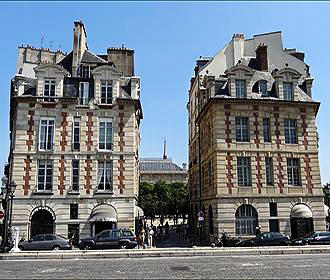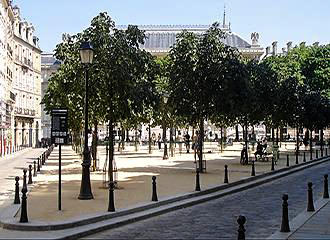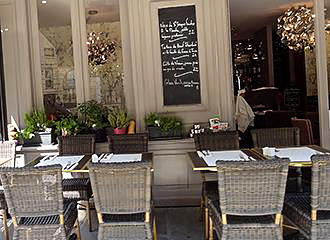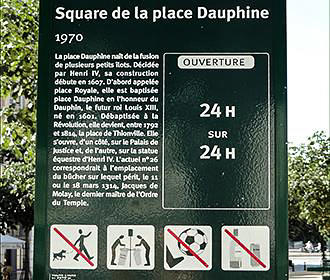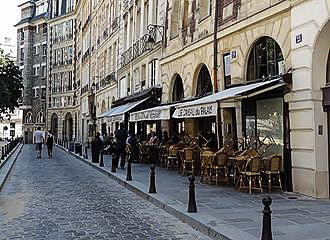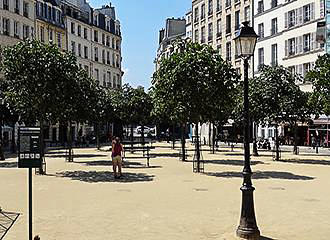Le Square de la Place Dauphine Square in Paris
The Place dauphine is a historical square in Paris named after the son of King Henri IV, which is located on the Ile de la Cite and was constructed while the Place des Vosges was being constructed and after the Pont Neuf Bridge had been built over the River Seine.
A bit of history
Originally King Henri II wanted a new bridge constructed at the tip of the Ile de la Cite island located in the River Seine, however, the first stone was only laid by King Henri III several years later, but was only completed under the reign of King Henri IV at the start of the 1600s.
During the time that the Pont Neuf, which is now the oldest bridge in Paris was nearing completion, a major task of constructing the Place Royale square was also started under the orders of King Henri IV, although this square today is now known as the Place des Vosges.
Yet after the bridge was finished, the king also decided that he wanted an additional square and garden in Paris to be located on the Ile de la Cite island by the original kings palace, which became the Palais de Justice.
And so he entrusted the work to Achille de Harlay, who was the chairman of parliament, with a condition that houses were to be constructed surrounding the square and would be similar to the plans drawn up for the Place Royale, such as stone and brick houses with the same facades, slate roofs, dormers and arcades.
And so, this triangular square in Paris was named Le Square de la Place Dauphine after the son of King Henri IV, who would become the future King Louis XIII, where thirty-two uniformed houses were constructed and the park was laid out with chesnut trees, which had become the popular choice.
Even though many of these houses have been completely transformed, increased in height or had their facades completely redone and one side even demolished in the 18th century after the fires during the Paris Commune, there are two Pavilions located by the Pont Neuf that connect the Ile de la Cite either side, that have remained intact and original.
Yet when King Henri IV died, his widow Marie de Medicis, who became the Regent of France, commissioned an equestrian statue of the king and this is to be seen in front of these two pavilions by the Square du Vert Galant.
Unfortunately, the original statue was destroyed during the French Revolution and even the name of the square was changed during this time to Place de Thionville. But after the monarchy was restored, a replica was produced in the early 1800s utilising the original cast and the bronze from a statue of General Louis Desaix, who was admired greatly by Napoleon Bonaparte, and in fact his name is one of those listed on the Arc de Triomphe, which is the most famous triumphal arch monument in Paris.
About Place Dauphine today
Officially known as Le Square de la Place Dauphine, this square in Paris opens on one side of the Palace of Justice, which is flanked by staircases and statues of lions, whereas on the other side is the equestrian statue of Henri IV.
It is shaded by numerous chestnut trees that were first introduced into parks and gardens in Paris during the 17th century and is a lovely space for a stroll by the Square du Vert Galant and where the Pon Neuf bridge intersects the Ile de la Cite.
There are plenty of benches to sit and relax in this park and square that is over 2,600 metres squared and being open every day of the year, it is also accessible to the disabled and wheelchair users.
You will also find that there are some restaurants in Paris with lovely terraces that are located close by, plus it is a lovely place to enjoy watching the boats going up and down the River Seine, or play a game of petanque, which is also known as French boules.
Access to Le Square de la Place Dauphine
Located on the Ile de la Cite in the 1st Arrondissement, you will be within walking distance of many different tourist attractions in Paris such as the Sainte Chapelle, the impressive Notre Dame Cathedral and the former palace turned prison called La Conciergerie, where Marie Antionette was held prior to her fate at the Place de la Concorde.
Being open all year round with wheelchair access, you can of course get to the Place Dauphine via the Pont Neuf bridge, yet the nearest Metro stations are the Cite stop or the Pont Neuf stop and you would need either line 4 or 7.
There are also Paris buses along with the Batobus water bus that stop close by, as do many of the tours in Paris, so there are numerous different types of public transport you can utilise to access this island, that has a history of Paris dating back to when it was known as Lutetia.
Address details
Le Square de la Place Dauphine, Ile de la Cite, 75001, Paris, Ile de France, France
Related information
Square de la Place Dauphine photos
Transport options
Paris Metro lines 4, 7
Bus lines 21, 24, 27
Bus line 38
Bus line 58
Bus lines 70, 72, 74, 75
Bus lines 81, 85
Bus line 96
Night bus lines N12, N13, N14, N15, N16
Night bus lines N21, N22
Water bus service
Attractions close by
King Henri IV statue
Pont Neuf
Square du Vert Galant
La Conciergerie
Sainte Chapelle
Place du Chatelet
Institut de France
Pont des Arts
Musee en Herbe
Musee du Louvre
Place Saint-Michel
Crypte Archeologique
Notre Dame de Paris
Tour Saint-Jacques
Le Procope restaurant
Marc Mitonne
Monument de l'Amiral Gaspard de Coligny
